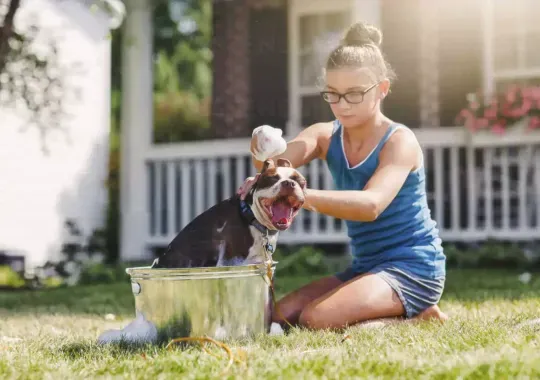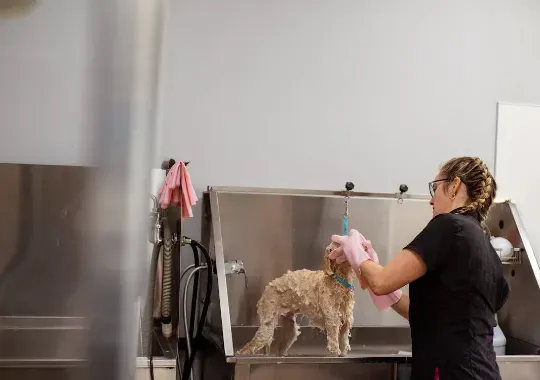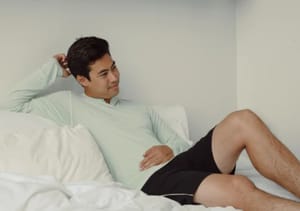Fleas, those tiny but relentless creatures, can turn your furry friend's life into an itchy nightmare. These blood-sucking parasites not only cause discomfort but can also transmit diseases to your canine companion. It's crucial to keep them at bay to ensure your dog's health and happiness. Now let's find out, What Human Shampoo Kills Fleas on Dogs.
As Amazon affiliates we may earn a commission if you purchase a product at no cost to you.

Watch this lovely video.
What Human Shampoo Kills Fleas on Dogs?
Myth vs. Reality: Can Human Shampoo Be Effective?
The idea of using your own human shampoo to deal with fleas on your furry friend might appear to be a convenient solution, but it's essential to differentiate between myth and reality in this matter.
Reality is a bit more complicated. While it's tempting to think that any shampoo designed for humans can effortlessly eliminate fleas on your dog, the truth is that human shampoos are formulated for human skin and hair, not the unique needs of a dog's coat and skin.
Here are some key points to consider:
pH Balance: Human skin is more acidic than a dog's skin. Using human shampoo can disrupt the natural pH balance of your dog's skin, potentially leading to irritation and skin issues.
Harsh Ingredients: Many human shampoos contain harsh detergents and fragrances that may be too harsh for a dog's sensitive skin, leading to dryness and discomfort.
Flea Eradication: While some human shampoos may temporarily wash away adult fleas, they are often ineffective at killing flea eggs and larvae, which are crucial for breaking the flea life cycle.
Flea-Specific Formulations: Shampoos designed explicitly for dogs often contain ingredients that target fleas and ticks while maintaining the health of your dog's skin and coat.
Ingredients to Look For and Avoid
If you're still considering using human shampoo for your dog's flea problem, it's essential to be selective about the ingredients. Here are some guidelines on what to look for and what to avoid:
Ingredients to Look For:
Mild Surfactants: Look for shampoos with mild surfactants like sodium laureth sulfate or sodium lauryl sulfate. These are less likely to irritate your dog's skin.
Natural Ingredients: Some human shampoos with natural ingredients like oatmeal or aloe vera can be gentler on your dog's skin.
No Harsh Fragrances: Avoid shampoos with strong, artificial fragrances as they can be overwhelming for your dog's sensitive nose.
Ingredients to Avoid:
Parabens: Parabens are preservatives commonly found in human shampoos but are best avoided for dogs as they can be harsh on their skin.
Sulfates: Avoid shampoos containing harsh sulfates like sodium lauryl sulfate, as they can strip natural oils from your dog's coat and skin.
Artificial Colors: Artificial colors can be unnecessary and may cause irritation in some dogs.
Chemical Pesticides: While not found in typical human shampoos, avoid any shampoos containing chemical pesticides, as they can be harmful to your dog.
In summary, while some human shampoos might offer a quick solution for washing away adult fleas, they may not be the safest or most effective option for comprehensive flea control in dogs. In the following chapters, we will explore alternative flea control methods and provide guidance on their use to ensure your dog remains comfortable and pest-free.

Human Shampoo Ingredients That Can Combat Fleas
When considering using human shampoo to combat fleas on dogs, it's essential to understand which ingredients might help in the fight against these persistent pests. In this chapter, we'll explore common agents found in human shampoos and their flea-fighting properties, as well as delve into the chemistry behind keeping your dog clean and flea-free.
Common Agents and Their Flea-Fighting Properties
Pyrethrin or Pyrethroid Compounds:
Pyrethrin, derived from chrysanthemum flowers, is a natural insecticide that can be found in some human shampoos. Pyrethroid compounds are synthetic versions of pyrethrin. These substances work by targeting the nervous systems of insects, paralyzing and killing them. However, they should be used with caution on dogs, as they can be toxic in high concentrations.
Citrus Extracts:
Citrus extracts like limonene and linalool are often used in human shampoos for their pleasant scents. These compounds also have natural insect-repellent properties. While they may help deter fleas to some extent, their effectiveness in eliminating a full-fledged infestation is limited.
Tea Tree Oil:
Tea tree oil is known for its antiseptic and anti-inflammatory properties. Some human shampoos contain this essential oil, which can help soothe irritated skin caused by flea bites. However, it's essential to dilute tea tree oil properly to avoid potential skin sensitivities in dogs.
Neem Oil:
Neem oil, derived from the neem tree, is a natural insect repellent. It can deter fleas and ticks while also soothing skin irritation. When used in moderation and correctly diluted, neem oil can be a useful ingredient in combating fleas on dogs.
Cedarwood Oil:
- Cedarwood oil has a strong, natural scent that can act as a repellent against fleas. While it may not eliminate an existing infestation, it can help prevent future flea problems.
Cedarwood oil has a strong, natural scent that can act as a repellent against fleas. While it may not eliminate an existing infestation, it can help prevent future flea problems.
Understanding the Chemistry Behind the Clean
The effectiveness of these flea-fighting ingredients lies in their chemical properties and how they interact with fleas:
- Insecticidal Action: Pyrethrin and pyrethroid compounds disrupt the nervous systems of fleas, leading to paralysis and death.
- Repellent Properties: Citrus extracts, tea tree oil, neem oil, and cedarwood oil create scents that fleas find unpleasant, deterring them from staying on your dog.
- Soothing Effects: Tea tree oil and neem oil also provide relief from itching and irritation caused by flea bites, promoting your dog's comfort.
While these ingredients may offer some benefits in the battle against fleas, it's crucial to remember that human shampoos are not formulated specifically for dogs. Their use should be approached with caution, and proper dilution and dosage are essential to avoid adverse effects.

Step-by-Step Guide: Using Human Shampoo Safely on Dogs
If you've decided to use human shampoo as a flea treatment for your dog, it's crucial to follow proper application techniques and ensure thorough rinsing and aftercare. This step-by-step guide will help you use human shampoo safely and effectively while prioritizing your furry friend's well-being.
Proper Application Techniques
Dilution:
- Dilute the human shampoo with warm water. Use a ratio of approximately one part shampoo to ten parts water. This dilution helps reduce the concentration of potential irritants while ensuring even coverage.
Wet Your Dog:
- Before applying the shampoo, thoroughly wet your dog's coat with warm water. Ensure that the water reaches the skin, as fleas often hide close to the skin.
Apply the Shampoo:
- Gently apply the diluted shampoo mixture to your dog's wet coat. Start from the neck and work your way down to the tail, ensuring you cover all areas.
Massage In:
- Massage the shampoo into your dog's coat using gentle, circular motions. Pay special attention to areas where fleas tend to hide, such as the neck, ears, and the base of the tail.
Avoid Eyes and Ears:
- Be extra cautious when shampooing around your dog's eyes and ears. To prevent shampoo from getting into these sensitive areas, use a washcloth or sponge to clean the face gently.
Leave for a Few Minutes:
- Allow the diluted shampoo to sit on your dog's coat for a few minutes. This gives the ingredients time to work on the fleas and helps remove dirt and debris from the coat.
Rinsing and Aftercare to Ensure Dog's Health
Rinse Thoroughly:
- Rinse your dog's coat thoroughly with warm water until all the shampoo is washed out. Incomplete rinsing can lead to skin irritation.
Towel Dry:
- Gently towel dry your dog to remove excess water. Avoid vigorous rubbing, as it can irritate the skin.
Post-Bath Care:
- After the bath, monitor your dog for any signs of skin irritation or allergic reactions. These can include excessive scratching, redness, or swelling.
Avoid Frequent Use:
- Limit the use of human shampoo on your dog. Frequent bathing can strip natural oils from your dog's coat and skin, leading to dryness and irritation.
Consider Alternatives:
- While human shampoo can be used occasionally, consider exploring dog-specific flea shampoos or alternative flea control methods for long-term flea prevention.
Consult a Vet:
- If you notice any adverse reactions or if your dog's flea problem persists, consult your veterinarian for guidance on alternative flea control options.
By following these proper application techniques and post-bath care guidelines, you can safely use human shampoo as a temporary flea control measure for your dog. However, remember that it's essential to prioritize your dog's health and comfort, and consider other flea control options for long-term effectiveness and safety.
Conclusion
In conclusion, while human shampoo can be used as a temporary flea control measure, it's essential to explore alternative natural remedies and consider veterinary-approved solutions for long-term flea prevention and management. Your veterinarian can provide expert guidance tailored to your dog's specific needs, ensuring a pest-free and comfortable life for your furry companion.
Recommended Article

Frequently Asked Questions FAQs
Can I use any human shampoo to kill fleas on my dog?
While some pet owners consider using human shampoo as a cost-effective option, it's essential to understand that human shampoos are formulated for human skin and hair. They may not be safe or effective for dogs, and they could potentially harm your pet's skin or coat. It's usually recommended to use shampoos specifically designed for dogs.
Are there any human shampoos that are safe for dogs and can help with fleas?
In general, human shampoos are not recommended for dogs to address flea problems. There are dog-specific flea shampoos and treatments that are formulated to be safe and effective for pets. Using these products is a more reliable and safer approach to combat fleas on your dog.
What should I do if I've used human shampoo on my dog to kill fleas?
If you've used human shampoo on your dog and suspect a flea problem, it's advisable to thoroughly rinse the dog with water to remove any residue. Then consult with your veterinarian for guidance on appropriate flea control methods for your pet. Using the right products designed for dogs is essential to ensure their safety and well-being.











